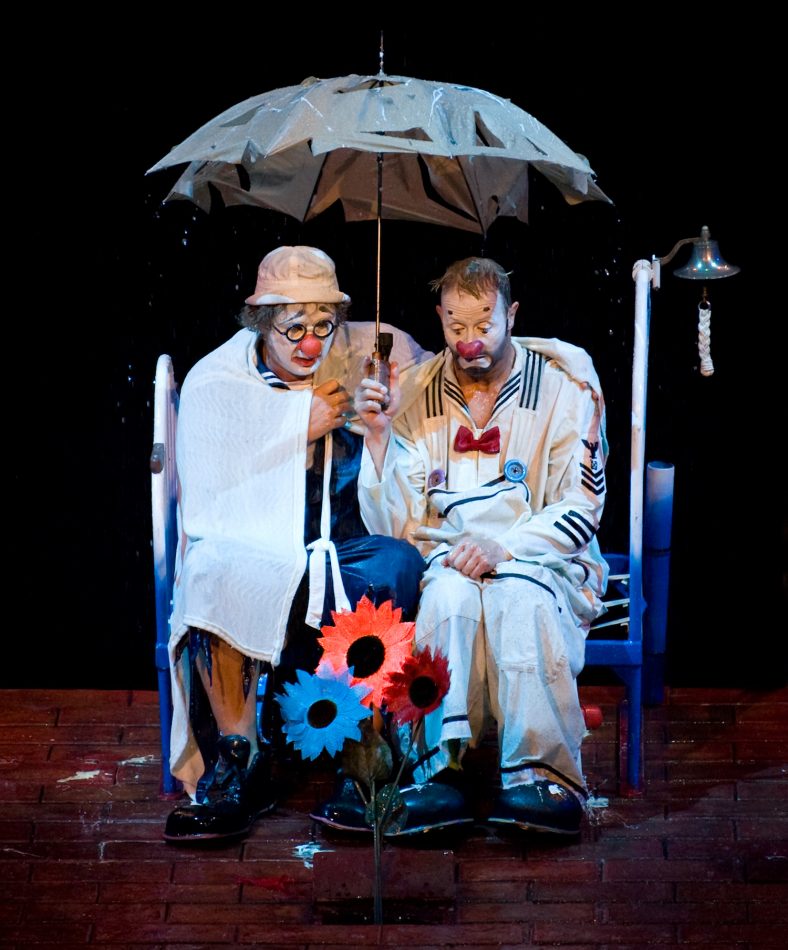I have to release the joke from the top: Cirque du Soleil’s “O” is a wholly immersive experience. Yes, “O,” (a phonetic rendering of the French eau for “water,”) is a water world: water is the flowing stage—often the literal stage—of the mesmerizing theatrics and flourishes of acrobats and dancers, trapeze artists and contortionists, clowns and lovers, all jumping into, out of, on top of and below the enormous pool, in which water is the most elemental of its elements.
Immersive indeed.
Before I get into the account of what it’s like to be dunked into the spiraling superlatives of the “O” experience, I have to record some statistics about it, because these stats are boggling, not boring. “O” is in its 20th year in the expansive Bellagio theater. Having been seen by 15 million people, “O” remains the most popular of Cirque’s stellar works. Since we’re speaking in millions, note as well that the show’s vast pool, 25 feet deep, holds 1.5 million gallons of the wet stuff. And that stage that moves above and below the pool is a shape-shifter: it uses the world’s largest underwater hydraulic system to whisk itself away with a whisper, revealing the depths below.
But, the play’s the thing. What happens in a Cirque performance? Well, everything. These are presentations where it would be best to have eight eyes, because besides an act taking place center stage—which in the case of “O” might mean center wave—there are always minor players performing some kind of hijinks on the side, or in the back or from platforms or ropes above.
Eight Eyes Might Not Be Enough
Thus, you might have a giant glowing entity with twenty-foot spikes of hair and shimmering costume descending from above (the ceiling’s height is 110 feet), singing with a penetrating but ethereal voice in a language unknown. That’s enough for four eyeballs, but you need the other four to see the antics of actors moving about the pool’s sides, perhaps chasing one another, doing backflips, diving in and out of the pool, prancing by in outlandish costumes (the guy with the small boat attached to his body was diverting), or gesturing emotionally to the audience, pleading for something mysterious but fraught.
What I’m getting at is that you think the performance has hit some kind of peak—driving music, tangoing acrobats, people launched into the water in pairs, fours, eights, people plummeting like colorful birds from high above into the water below. But then you realize it’s just another pulse of activity, crescendo upon crescendo, inspired madness from highly trained methods.
That training is always in evidence. The players in the performance are remarkably skilled; the spectacular ballet of the human body is exquisitely expressed. There are seven Olympians in the troupe, which hints at skill levels. When the contortionists start to pile atop each other in impossible ways, their legs thrust in a full-body twist down from behind so they can put feet flat on the floor in front of their faces, I could barely look out of fear something would break. How can you convince your body to do that? Fear is one of the compelling components of the show: the fellow who seemed to be fully on fire, hat included, who stomped nonchalantly about while his clothing brightly burned terrified me.
Thank god for the apparent samurai in the bustier, whose manly paradings in his delicate attire took my mind off the burning man.
I also have to mention one of the interlude-type moments that periodically occur amidst the mania of the performance cannons, and that provided some good comic relief: a couple of clown characters who floated on the pool on a kind of small barge, trying to stave off leaks and boredom with cuckoo antics, the main clown’s voice coming across as a series of honks, beeps and strange murmurs. Hard to describe, but absurdist fun.
All Performances Are in Flow
I have to get back to my little immersive joke with another: every part of “O” is fluid. (Ah, water jokes, drink enough of them and you’ll swim with the tides.) New phases or acts in the show flow in and out, the stage rises and falls (the illusion of people walking on water is done well) and cracklingly good bursts of athletic and theatric excellence roll on without a stitch showing. It’s hypnotizing in the best of ways.
A small part of that hypnosis may have been the champagne. Being part of a media group, hosted by the friendly folks at MGM Resorts International and Kirvin Doak PR, we were in the VIP suites, which include a behind-the-scenes overview of the show, photographs with some of the cast, champagne with complimentary flutes, then a private booth for the show—where the Veuve Cliquot kept on flowing—a box of yummy chocolate truffles, and enough friendly attention to make me think being a writer isn’t the squalid vocation others ascribe it to be.
By the way, after all the wine and champagne, I was ready to jump in the pool with the Cirque people, but it was late. Maybe next time.
Vegas is no stranger to fanciful transformation, so the thought that this large theater is patterned after a 14-century opera house isn’t surprising. But “O” isn’t Vegas glitz: it’s absorbing and entrancing stuff. You might think synchronized swimming is an odd sport for the Olympics, but in “O” it’s just one layer of a weirdly wonderful water world. Go to “O” and you’ll be saying “Oh!” over and over again.











Leave a Reply